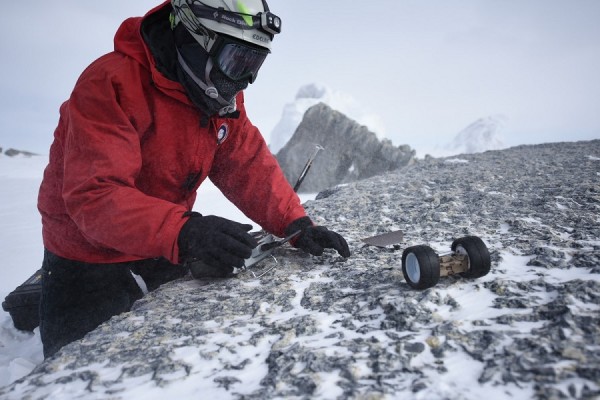By Ana Verayo, | March 23, 2017

PUFFER was outfitted for field testing in snow during a recent trip to Antarctica’s Mt. Erebus
NASA's Curiosity rover is one of the robotic explorers that is currently examining the habitability of Mars. However, there are limitations when it comes to these rovers, and a smaller robotic version might help NASA. Smaller robots also mean that they can handle tougher terrain and squeeze into rock crevices where organic molecules are hiding.
Like Us on Facebook
NASA researchers are now developing a new robot called the PUFFER (Pop-Up Flat Folding Explorer Robot) that is inspired by the traditional Japanese art of origami. Initial plans started as a paper robot with four wheels and then researchers replaced the robot's main body with a printed circuit board to apply electronics. Researchers also utilized only two wheels instead and four and fitted them with treads to traverse inclines.
Apart from these, the wheels can be folded inward to reduce the size of this robot to the size of a smartphone. This also means that many PUFFER robots can be stacked on top of each other to transport them more easily. The PUFFER robot can not only move forward but can crawl into tight spaces and under ledges and can be dropped into pits and craters.
The team of the PUFFER project under NASA's Game Changing Development (GCD) program has tested this robot on Mount Erebus, which is an active volcano in Antarctica, across the rocky landscape of the Rainbow Basin in California and in a ski resort in Colorado to test its capability to adapt in snowy or icy environments.
Researchers also created a "skittering walk mode" for PUFFER to help it inch forward slowly for each wheel to prevent slippage. This is very crucial when the robot is walking up to steeper inclines with surfaces that do not provide enough traction. This walk mode can also provide more stability for the tiny robot.
Apart from this mode, the solar panels are located on its belly which means that the robot can flip over during charging. When PUFFER is flat on the ground, it can travel for 625 meters for every charge.
PUFFER will also serve as a scientific laboratory, fully equipped with a suite of scientific instruments. It will be fitted with a micro imager that can zoom in tiny objects, around 10 microns in size. There will also be a spectrometer to measure the chemistry of rocks and samples and even test water for organic matter. In the future, PUFFER will also have an autonomous function so that it can be deployed to other planets as well.
-
Use of Coronavirus Pandemic Drones Raises Privacy Concerns: Drones Spread Fear, Local Officials Say

-
Coronavirus Hampers The Delivery Of Lockheed Martin F-35 Stealth Fighters For 2020

-
Instagram Speeds Up Plans to Add Account Memorialization Feature Due to COVID-19 Deaths

-
NASA: Perseverance Plans to Bring 'Mars Rock' to Earth in 2031

-
600 Dead And 3,000 In The Hospital as Iranians Believed Drinking High-Concentrations of Alcohol Can Cure The Coronavirus

-
600 Dead And 3,000 In The Hospital as Iranians Believed Drinking High-Concentrations of Alcohol Can Cure The Coronavirus

-
COVID-19: Doctors, Nurses Use Virtual Reality to Learn New Skills in Treating Coronavirus Patients








